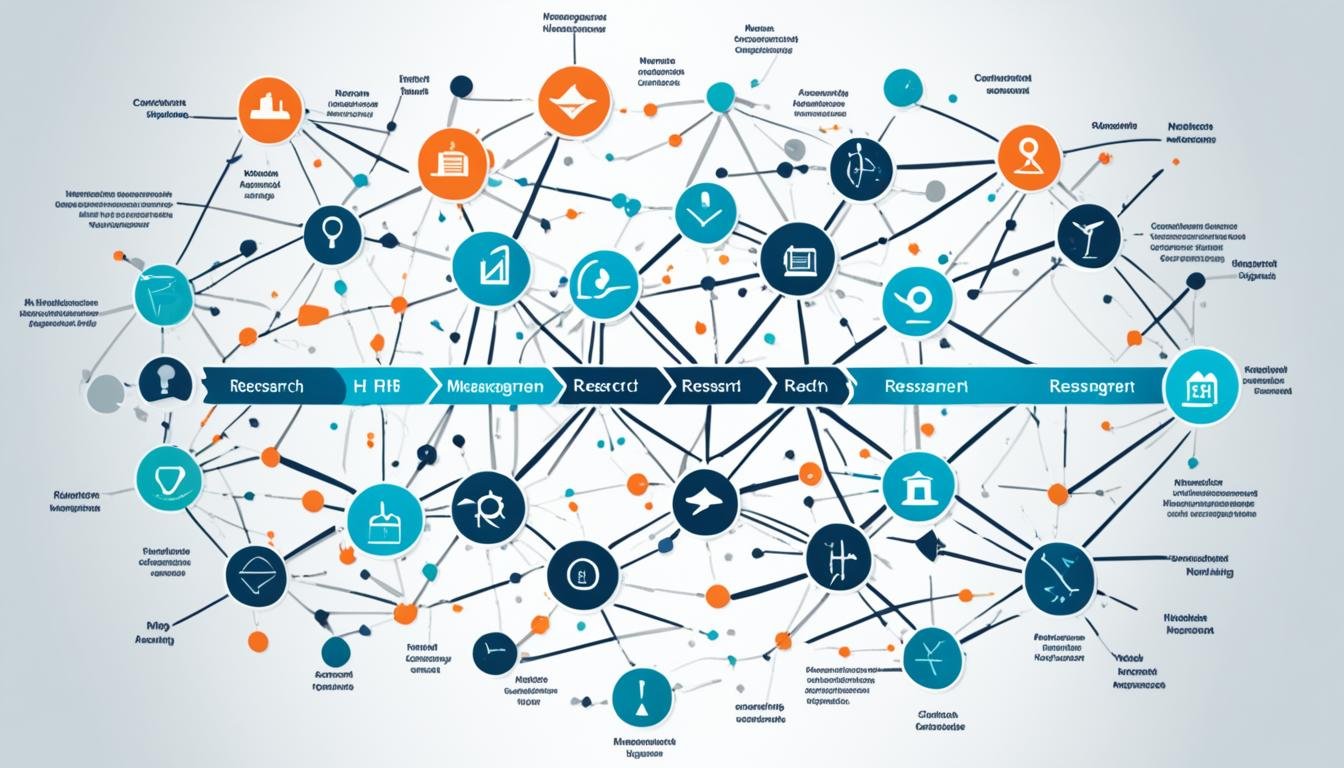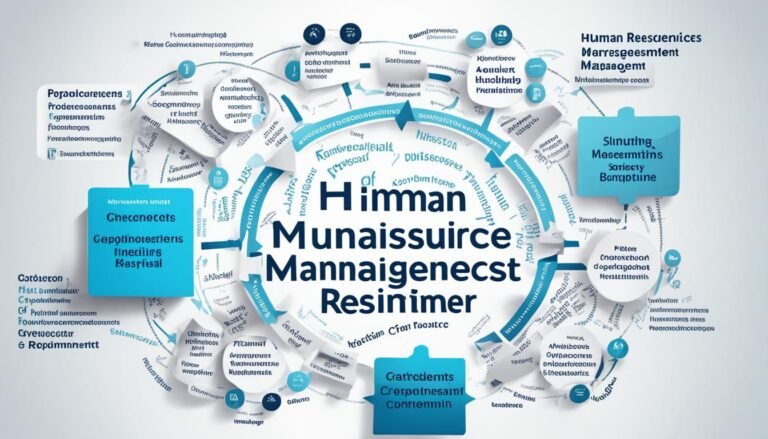A Guide to Human Resources Management Research
Managing human resources effectively is essential for the success of any organization. As businesses navigate the complexities of the modern workforce, it becomes crucial to stay informed and up-to-date on the latest research and practices in human resources management (HRM).
HR management research provides valuable insights into the various aspects of managing employees, from recruitment and performance evaluation to training and development. It explores the strategic role of HR in supporting organizational objectives and analyzes the impact of HRM practices on employee engagement and productivity.
This article aims to guide HR professionals, business owners, and managers in understanding the importance of HR management research and its practical applications. It discusses the current trends, challenges, and best practices in HRM, offering valuable information to enhance HR strategies and improve organizational outcomes.
Key Takeaways:
- – HR management research provides valuable insights into effective employee management.
- – Understanding the strategic role of HR is crucial for achieving organizational goals.
- – Investing in HRM can enhance employee engagement and productivity.
- – HRM research helps identify best practices for recruitment, training, and development.
- – Staying updated on the latest HRM trends and challenges is essential for HR professionals.
Importance of HR Management for SMBs
Effective HR management is crucial for small and medium-sized businesses (SMBs). Investing in HR from the start is as important as investing in marketing and sales. SMB HR management involves more than just managing people; it includes creating policies and procedures that support business objectives and developing a positive workplace culture to improve employee performance.
Neglecting HR can have serious consequences for SMBs. It can lead to costly penalties for non-compliance with labor laws, damage the company’s reputation, and make it difficult to attract and retain top talent. Without proper HR management, businesses face challenges in addressing employee concerns, implementing effective performance management, and fostering employee growth.
To ensure workplace efficiency and achieve key goals, SMBs need to prioritize HR management. By investing in HRM practices, SMBs can:
- Recruit and retain top talent: Effective HR management strategies enable SMBs to attract and retain skilled employees who contribute to the organization’s growth.
- Ensure regulatory compliance: HR management ensures SMBs adhere to labor laws and regulations, minimizing legal risks and potential penalties.
- Create a positive work culture: HR practices promote a positive work environment, leading to higher job satisfaction, engagement, and productivity among employees.
- Develop employees: HR management focuses on employee development through training programs, performance evaluations, and career growth opportunities, leading to better employee performance and retention.
In summary, SMBs should recognize the importance of HR management. By investing in effective HR practices, SMBs can overcome challenges, improve workplace efficiency, and create a positive work environment that attracts and retains top talent.
Quote:
“Investing in HR management is not just an expense for SMBs; it’s an investment that yields long-term benefits in terms of employee satisfaction, productivity, and business success.” – HR Expert
Key Functions of HR Management
The key functions of HR management play a crucial role in ensuring the success of an organization. These functions encompass a wide range of responsibilities that contribute to the effective management of the workforce. By understanding and executing these functions, HR professionals can create a positive and productive work environment.
Here are some of the key functions of HR management:
- Hiring the right people: HR professionals are responsible for attracting and selecting the most suitable candidates for job openings. They oversee recruitment processes, conduct interviews, and make informed decisions on hiring.
- Determining appropriate compensation: HR management ensures that employees are paid competitively and fairly. It involves evaluating market trends, conducting salary surveys, and establishing compensation structures that align with organizational goals.
- Managing health and safety policies: HR professionals are responsible for creating and implementing policies and procedures to ensure the health and safety of employees. They monitor compliance with regulations, conduct risk assessments, and promote a safe working environment.
- Handling employee grievances: HR management deals with employee complaints and concerns. HR professionals act as mediators, investigate issues, and provide guidance to resolve conflicts in a fair and timely manner.
- Evaluating performance: HR professionals develop and implement performance appraisal systems to assess employee performance. They provide feedback, set goals, and identify areas for improvement to enhance individual and organizational performance.
- Recognizing high performers: HR management plays a crucial role in recognizing and rewarding high-performing employees. This function includes implementing employee recognition programs, providing incentives, and fostering a culture of appreciation.
- Setting up training initiatives: HR professionals are responsible for identifying employee development needs and designing training programs to enhance skills and capabilities. They ensure that employees have the necessary knowledge and resources to perform their job effectively.
These functions of HR management are vital for the smooth functioning of an organization. They contribute to attracting and retaining talented individuals, ensuring compliance with laws and regulations, fostering employee growth and engagement, and improving overall productivity.
HR Operational Areas
HR management encompasses various operational areas that support the overall functions within the HR department. These areas include:
- Talent acquisition and onboarding
- Employee relations
- Compensation and benefits
- Training and development
- Performance management
- Employee engagement
- HR analytics and reporting
- Compliance and legal considerations
Each of these operational areas plays a critical role in managing the workforce effectively and ensuring the success of HRM strategies.
In the next section, we will explore the challenges and trends in HR management that organizations need to navigate in today’s dynamic business landscape.
Challenges and Trends in HR Management
HR management faces numerous challenges and trends, especially in light of the shift to hybrid work models and dynamic talent landscapes. As organizations adapt to new ways of working, HR leaders must navigate various obstacles to effectively manage their workforce and align HR practices with emerging trends.
One of the key challenges HR management has faced is the impact of the COVID-19 pandemic. During this uncertain time, HR professionals have had to swiftly adapt to remote work arrangements and implement health and safety protocols to ensure employee well-being. Additionally, HR leaders have had to address employee burnout, which has become a major concern. According to a recent study, over 70% of HR leaders worry about employee burnout and its detrimental effects on productivity and engagement.
Financial constraints have also posed significant challenges for HR management. With limited resources, HR leaders must find ways to optimize their budget while still meeting the evolving needs of the workforce. This has led to a growing demand for alternative HR models that are more agile, cost-effective, and strategically aligned with business priorities.
To overcome these challenges and stay ahead of emerging trends, HR leaders are increasingly turning to the latest HRM models, systems, and software. These tools provide valuable support in managing and engaging a diverse and dispersed workforce. By leveraging technologies such as HR analytics, automation, and employee engagement platforms, HR departments can streamline processes, enhance decision-making, and drive organizational transformation.
HR transformation is a growing trend in the field, with organizations recognizing the need for HR to evolve and align with broader business objectives. This involves adopting a more strategic approach to HR management, focusing on data-driven insights, and leveraging technology to deliver enhanced employee experiences and drive organizational performance.
HR leaders are seeking alternative models that are more agile and strategically aligned with business priorities.
The Need for Agile HRM Models
As organizations navigate the challenges and trends in HR management, HRM models have become crucial in driving success. Agile HRM models provide the flexibility and adaptability needed to respond to changing business needs and workforce dynamics.
One example of an agile HRM model is the “Centers of Expertise” approach, which involves establishing specialized HR teams that focus on key areas such as talent acquisition, learning and development, or employee engagement. This model enables HR to become more strategic by leveraging specialized knowledge and expertise, resulting in improved outcomes and performance.
Another emerging trend is the integration of HR technology and data analytics into HRM models. By harnessing the power of data, organizations can gain valuable insights into employee performance, engagement levels, and workforce trends. This enables HR to make data-driven decisions, identify areas for improvement, and proactively address challenges.
Overall, the challenges and trends in HR management require HR leaders to be proactive, innovative, and adaptable. By embracing agile HRM models and leveraging technology, HR departments can navigate these challenges effectively and drive positive change within their organizations.
Key HR Management Challenges and Trends
| Challenges | Trends |
|---|---|
| Impact of COVID-19 on workforce management | Integration of technology and data analytics |
| Employee burnout and well-being | Focus on agile HRM models |
| Financial constraints | HR transformation |
Benefits of HRM Software for SMBs
Implementing HRM software can bring numerous benefits to SMBs. By investing in people-centric, data-powered solutions, such as HR software, businesses can improve the hiring and onboarding process, manage people more effectively to maintain compliance and optimize productivity, and make data-driven decisions to drive growth.
HR software offers a wide range of features and tools that cater to the unique needs of SMBs. Some key benefits include:
- Improved payroll processing accuracy: HR software automates the payroll process, minimizing errors and ensuring accurate calculations.
- Employee performance management: HR software provides a centralized platform for tracking and evaluating employee performance, enabling managers to identify top performers and address any performance issues.
- Task automation: HR software streamlines routine HR tasks, such as leave management, timesheet tracking, and employee onboarding, reducing administrative burdens and freeing up HR professionals to focus on strategic initiatives.
Furthermore, HR software offers additional features like employee self-service portals for easy access to information and requests, benefits administration to manage employee benefits, and compliance tracking and reporting to ensure adherence to labor laws and regulations.
| Benefits of HRM Software for SMBs | Description |
|---|---|
| Improved efficiency | Automates HR processes and reduces manual tasks, allowing HR professionals to focus on strategic activities. |
| Enhanced compliance | Ensures adherence to labor laws and regulations, minimizing compliance risks. |
| Better decision-making | Provides access to real-time HR data and analytics, enabling data-driven decision-making. |
| Streamlined communication | Facilitates effective communication between HR, employees, and managers, ensuring transparency and collaboration. |
| Improved employee experience | Enables self-service portals, empowers employees to access information and manage HR-related tasks, and creates a positive employee experience. |
It is crucial for SMBs to find an HR software solution that meets their specific needs and fits within their budget. By leveraging the functionalities and benefits of HR software, SMBs can effectively manage their HR processes, foster employee engagement, and drive business success.
Must-Read HR Books for HR Professionals
Staying up to date with the latest information is crucial for HR professionals. To enhance your knowledge and stay ahead in the field, consider adding the following must-read HR books to your reading list:
1. “Human Resources Management” by Gary Dessler
This comprehensive book provides an in-depth overview of HR management, covering topics such as recruitment, training and development, employee relations, performance management, and more. It serves as a valuable resource for both beginners and experienced HR professionals.
2. “HR from the Outside In” by Dave Ulrich
Dave Ulrich’s book explores the key competencies required for HR professionals to succeed. It offers insights into aligning HR strategies with business objectives, driving organizational change, and developing HR as a strategic partner. This book is essential for HR leaders aiming to shape the future of the profession.
3. “HR Analytics Handbook” by Laurie Bassi and others
For HR professionals interested in leveraging data to drive decision-making, this book offers practical guidance on implementing HR analytics initiatives. It covers important topics like collecting and analyzing HR data, interpreting findings, and using analytics to inform talent management strategies.
4. “The Talent Management Handbook” by Lance Berger and Dorothy Berger
This handbook provides a comprehensive guide to talent management best practices, offering insights into attracting, developing, and retaining top talent. It covers topics such as succession planning, leadership development, performance management, and employee engagement.
5. “HR on Purpose: Developing Deliberate People Passion” by Steve Browne
Steve Browne’s book focuses on the human side of HR, emphasizing the importance of developing a people-centric approach. It explores the role of HR in creating a positive workplace culture, fostering employee engagement, and driving organizational success.
“To be successful in HR, you must embrace the business as your own and drive the HR agenda to create an environment where talent flourishes and the organization succeeds.”
– Steve Browne
6. “The Future of HR: Rise of Automation, Artificial Intelligence, and Human-Computer Collaboration” by David Green
In this thought-provoking book, David Green discusses the future of HR in the age of automation and AI. It explores the opportunities and challenges of integrating technology in HR practices and emphasizes the importance of human-computer collaboration.
By delving into these HR books, you can expand your knowledge and gain valuable insights into HR management, analytics, talent management, and future trends. Remember, continuous learning is key to excelling in the dynamic field of HR.
SHRM Research Resources for HR Professionals
The Society for Human Resource Management (SHRM) provides a wealth of research resources to support HR professionals in their decision-making and strategic planning. These resources offer valuable insights into various aspects of HR management and can help professionals stay informed about the latest trends and best practices in the industry.
Here are some of the key SHRM research resources that HR professionals can access:
- SHRM Employee Benefits Survey: This survey covers the latest trends and practices in employee benefits, including health insurance, retirement plans, and other perks offered by organizations.
- SHRM Voice of Work Research Panel: This diverse group of HR professionals represents the collective voice of the workplace. Their insights and experiences provide valuable perspectives on HR-related topics.
- SHRM Benchmarking: This resource provides access to key HR and business metrics, allowing HR professionals to compare their organization’s practices and performance against industry benchmarks.
- Research Reports: SHRM offers a wide range of research reports on topics such as organizational resilience, employee experience, and the state of the workplace. These reports provide comprehensive analysis and actionable insights on critical HR issues.
By leveraging these SHRM research resources, HR professionals can access reliable data and expert analysis to inform their decision-making and drive strategic initiatives within their organizations.
Importance of Employee Experience in HR
Employee experience has become a significant focus for organizations, recognizing its role in determining employee satisfaction, engagement, and ultimately, retention. By prioritizing employee experience, HR departments can create a positive work environment that fosters productivity and enhances overall company performance.
Measuring and understanding employee experience involves various HR metrics, such as job satisfaction, engagement levels, and turnover intent. These metrics provide valuable insights into the overall mood and well-being of the workforce, helping HR professionals identify areas for improvement and develop targeted strategies to enhance employee experience.
Improving employee experience goes beyond addressing individual concerns; it requires HR to take a holistic approach to create an inclusive and supportive work culture. By implementing initiatives that prioritize employee well-being, such as wellness programs, flexible work arrangements, and professional development opportunities, HR can significantly impact employee engagement and satisfaction.
The Benefits of Focusing on Employee Experience:
- Enhanced Employee Satisfaction: By understanding and addressing employee needs and concerns, HR can improve overall satisfaction levels, leading to a more motivated and productive workforce.
- Increased Employee Engagement: A positive employee experience creates a sense of belonging and purpose, leading to higher levels of employee engagement, commitment, and discretionary effort.
- Reduced Employee Turnover: When employees feel satisfied and engaged, they are more likely to stay with the organization, reducing turnover rates and the associated costs of recruitment and training.
- Improved Performance and Productivity: By creating a supportive work environment, HR can enhance employee performance, productivity, and collaboration, leading to better business outcomes.
“Investing in employee experience is not just a feel-good initiative; it’s a strategic approach to HR management that can yield tangible benefits for both employees and the organization as a whole.”
By prioritizing employee experience and leveraging HR metrics, organizations can cultivate a positive workplace culture that attracts and retains top talent, fosters growth and development, and drives long-term success.
Unlocking the Full Potential of Financial Wellness Benefits
Providing financial wellness benefits to employees can have a significant impact on their overall well-being and productivity. It is essential for organizations to recognize the importance of prioritizing employee financial wellness and understand how to unlock its full potential. By implementing comprehensive financial education programs, utilizing financial wellness tools, and offering HR wellness programs, organizations can empower their employees to improve their financial well-being and make better financial decisions.
The Importance of Employee Financial Wellness
Employee financial wellness plays a vital role in their overall well-being. Financial stress can negatively affect employees’ mental and physical health, leading to decreased productivity and engagement. By focusing on financial wellness, organizations can help alleviate financial stress and create an environment where employees feel supported and empowered.
Financial wellness benefits can include various initiatives such as employee assistance programs, retirement savings plans, debt management resources, and budgeting tools. These benefits not only enhance employees’ financial well-being but also contribute to their job satisfaction and loyalty to the organization.
Comprehensive Financial Education
A key component of unlocking the full potential of financial wellness benefits is providing employees with comprehensive financial education. Organizations can offer workshops, seminars, and online resources that cover topics such as budgeting, saving, investing, and managing debt.
By equipping employees with the necessary financial knowledge and skills, organizations empower them to make informed decisions and take control of their financial futures. Financial education also helps build confidence and reduces financial stress, leading to improved overall well-being and productivity.
Financial Wellness Tools
Implementing financial wellness tools is another crucial aspect of maximizing the benefits of financial wellness programs. These tools can include personalized financial management apps, online budgeting platforms, and retirement planning calculators.
Financial wellness tools provide employees with real-time insights into their financial situations, helping them set goals, track progress, and make informed financial decisions. By offering these tools, organizations demonstrate their commitment to supporting employees’ financial well-being and empowering them to take charge of their financial lives.
HR Wellness Programs
Integrating financial wellness into HR wellness programs can amplify the impact on employee well-being. By combining financial wellness benefits with other aspects of well-being, such as physical and mental health, organizations create a holistic approach to employee wellness.
HR wellness programs can include incentives for healthy behaviors, access to wellness resources, and support for work-life balance. Combining financial wellness with these programs reinforces the message that employee well-being is a top priority and creates a culture of overall wellness within the organization.
Unlocking the Full Potential
Unlocking the full potential of financial wellness benefits requires a comprehensive approach that includes financial education, the use of financial wellness tools, and integration with HR wellness programs. By investing in employee financial wellness, organizations can foster a healthier, more engaged, and productive workforce. It is an investment that pays off in the form of improved employee satisfaction, retention, and overall business success.
| Benefits of Financial Wellness Programs |
|---|
| Reduces financial stress |
| Improves employee well-being and productivity |
| Enhances job satisfaction and loyalty |
| Empowers employees to make better financial decisions |
| Contributes to a positive workplace culture |
Conclusion
In conclusion, effective HR management is crucial for organizations, especially SMBs. By investing in HRM and prioritizing the needs of their workforce, businesses can improve workplace efficiency, attract and retain top talent, and achieve key goals. The role of HRM goes beyond managing people; it involves creating policies and procedures that align with organizational objectives and fostering a positive workplace culture to enhance employee performance.
Staying informed about the latest HR trends and challenges is essential for HR leaders. They can leverage resources such as HRM software, research reports, and HR books to enhance their knowledge and skills. HRM software, in particular, offers features like improved payroll accuracy, employee performance management, and task automation, which can streamline HR processes and drive productivity.
Adopting best practices and focusing on employee experience are also keys to success in HR management. By prioritizing employee well-being, organizations can create a positive work environment that enhances engagement, performance, and retention. It is important for HR leaders to implement comprehensive financial wellness benefits and provide employees with the necessary resources and tools to improve their financial well-being.
Overall, by embracing HRM best practices, staying informed, and prioritizing employee experience, organizations can establish a solid foundation for success, drive business growth, and create a thriving workplace culture.







